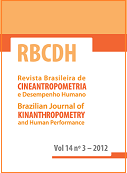Frequency band analysis of muscle activation during cycling to exhaustion
DOI:
https://doi.org/10.1590/1980-0037.2012v14n3p243Abstract
Lower limb muscles activation was assessed during cycling to exhaustion using frequency band analysis. Nine cyclists were evaluated in two days. On the first day, cyclists performed a maximal incremental cycling exercise to measure peak power output, which was used on the second day to define the workload for a constant load time to exhaustion cycling exercise (maximal aerobic power output from day 1). Muscle activation of vastus lateralis (VL), long head of biceps femoris (BF), lateral head of gastrocnemius (GL), and tibialis anterior (TA) from the right lower limb was recorded during the time to exhaustion cycling exercise. A series of nine band-pass Butterworth digital filters was used to analyze muscle activity amplitude for each band. The overall amplitude of activation and the high and low frequency components were defined to assess the magnitude of fatigue effects on muscle activity via effect sizes. The profile of the overall muscle activation during the test was analyzed using a second order polynomial, and the variability of the overall bands was analyzed by the coefficient of variation for each muscle in each instant of the test. Substantial reduction in the high frequency components of VL and BF activation was observed. The overall and low frequency bands presented trivial to small changes for all muscles. High relationship between the second order polynomial fitting and muscle activity was found (R2 > 0.89) for all muscles. High variability (~25%) was found for muscle activation at the four instants of the fatigue test. Changes in the spectral properties of the EMG signal were only substantial when extreme changes in fatigue state were induced.



